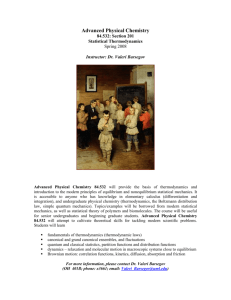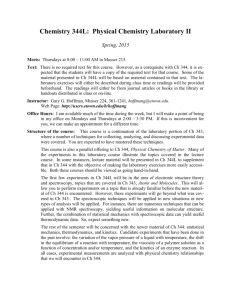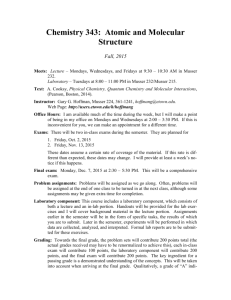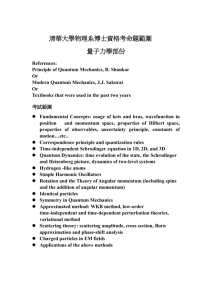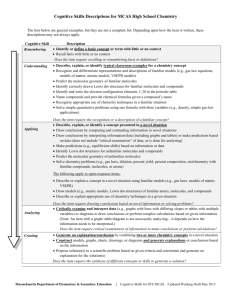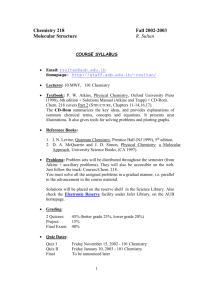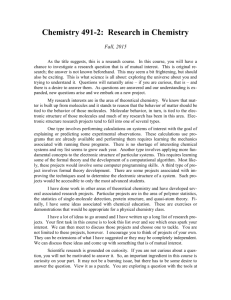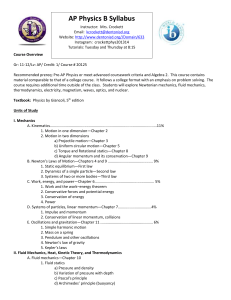Syllabus - My E-town -- Personal Home Pages
advertisement
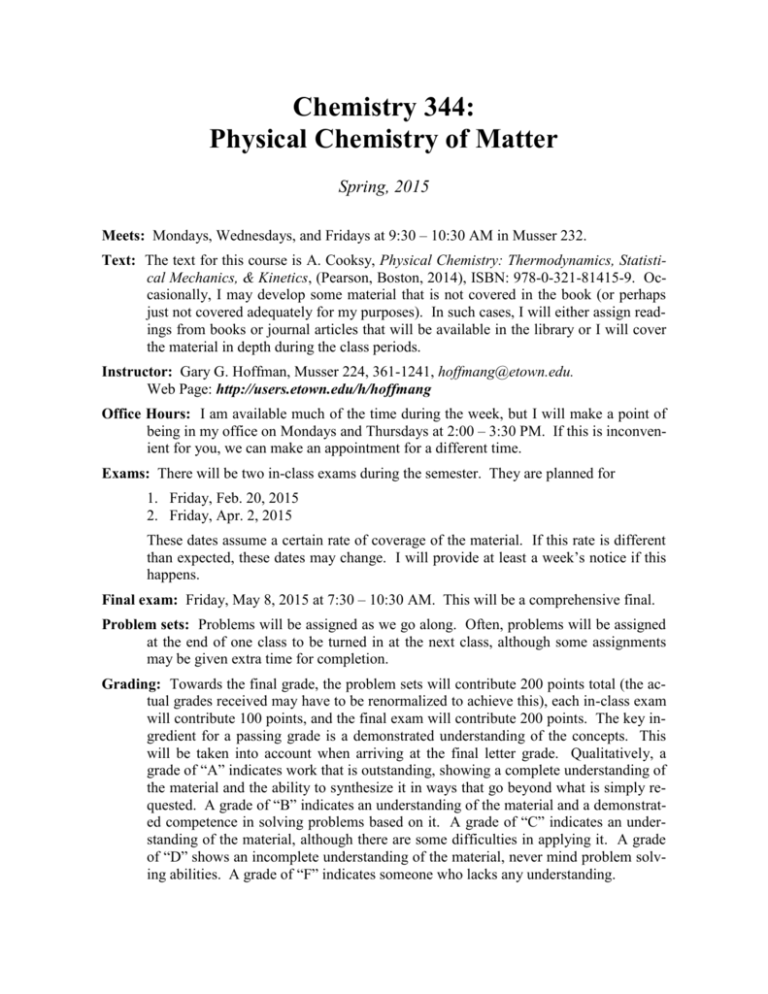
Chemistry 344: Physical Chemistry of Matter Spring, 2015 Meets: Mondays, Wednesdays, and Fridays at 9:30 – 10:30 AM in Musser 232. Text: The text for this course is A. Cooksy, Physical Chemistry: Thermodynamics, Statistical Mechanics, & Kinetics, (Pearson, Boston, 2014), ISBN: 978-0-321-81415-9. Occasionally, I may develop some material that is not covered in the book (or perhaps just not covered adequately for my purposes). In such cases, I will either assign readings from books or journal articles that will be available in the library or I will cover the material in depth during the class periods. Instructor: Gary G. Hoffman, Musser 224, 361-1241, hoffmang@etown.edu. Web Page: http://users.etown.edu/h/hoffmang Office Hours: I am available much of the time during the week, but I will make a point of being in my office on Mondays and Thursdays at 2:00 – 3:30 PM. If this is inconvenient for you, we can make an appointment for a different time. Exams: There will be two in-class exams during the semester. They are planned for 1. Friday, Feb. 20, 2015 2. Friday, Apr. 2, 2015 These dates assume a certain rate of coverage of the material. If this rate is different than expected, these dates may change. I will provide at least a week’s notice if this happens. Final exam: Friday, May 8, 2015 at 7:30 – 10:30 AM. This will be a comprehensive final. Problem sets: Problems will be assigned as we go along. Often, problems will be assigned at the end of one class to be turned in at the next class, although some assignments may be given extra time for completion. Grading: Towards the final grade, the problem sets will contribute 200 points total (the actual grades received may have to be renormalized to achieve this), each in-class exam will contribute 100 points, and the final exam will contribute 200 points. The key ingredient for a passing grade is a demonstrated understanding of the concepts. This will be taken into account when arriving at the final letter grade. Qualitatively, a grade of “A” indicates work that is outstanding, showing a complete understanding of the material and the ability to synthesize it in ways that go beyond what is simply requested. A grade of “B” indicates an understanding of the material and a demonstrated competence in solving problems based on it. A grade of “C” indicates an understanding of the material, although there are some difficulties in applying it. A grade of “D” shows an incomplete understanding of the material, never mind problem solving abilities. A grade of “F” indicates someone who lacks any understanding. Prerequisite: Chemistry 343, Atomic Structure. Structure of the course: This course is a continuation of Chemistry 343: Atoms and Molecules. In the first semester, the concepts of quantum mechanics were developed and then applied to a number of systems. Initial applications were to simpler systems, providing illustrations of some of the general principles of quantum mechanics. Applications were then made to successively more complex systems, culminating in atoms and molecules, the building blocks of matter. One of the important consequences of quantum mechanics is that a given atom or molecule can exist only with certain, specific energies – the energy of an atom or molecule is quantized. Although the specific energies can be fully predicted only by solving the Schrödinger equation, some general mathematical forms were deduced for certain types of energies, for instance, the rotational and vibrational motions of a molecule. Chemistry 344 starts from this point and puts molecules together to form matter. Matter that we can see and perform experiments with contains a gigantic number of molecules – typically on the order of 1023. In principle, the behavior of bulk matter is a consequence of the behavior of the individual molecules. To predict its behavior, we would have to solve the Schrödinger equation for the bulk system, but the huge number of molecules makes such a task formidable, if not impossible. Fortunately, though, we can focus on the individual molecules and, through the use of statistics, deduce the average behavior of the molecules in the system. The feature that makes solution of the Schrödinger equation so difficult – the huge number of molecules – actually makes the application of a statistics more reliable. This field of study is referred to as statistical mechanics. It is a fascinating field in which much research is being done, but at the undergraduate level, we can only brush the surface of it. I hope to whet your appetite and encourage those of you with an interest to study the field in more depth. The next step is to identify the connection between the molecular level properties and bulk level properties and, in this way, deduce connections between different bulk level properties. In essence, the complicated details of quantum mechanics are pushed into the background and we end up with a theory that relates only bulk level properties. This is the more familiar field of thermodynamics. This field is not as predictive as statistical mechanics – that is, we cannot predict the behavior of a sample of matter simply by specifying its composition and environment. However, by providing some additional information – for instance, heat capacities or heats of combustion – predictions can be made of how the system will behave as conditions are changed. Thermodynamics can be applied to any chemical system and a large portion of the semester will be devoted to this subject. After developing the fundamental laws of thermodynamics, we will look at pure systems, mixtures, and reacting chemical systems. Some general principles of chemistry can be deduced in this way. The final topic of Chemistry 344 is chemical kinetics. The dynamic properties of chemical reactions will be studied, identifying how the rate of a chemical reaction can be affected and how to quantify these effects. The study of reaction mechanisms based on kinetics will also be studied. Throughout the two-semester sequence, you should recognize the logical progression that is made. We start at the basic level of nuclei and electrons, introduce the physical principles (quantum mechanics) that are needed to deal with such particles, put them together to form atoms, build molecules from those atoms, and then put these molecules together to make the bulk material that we interact with more directly in our everyday life. You should develop a feel for how matter is put together and what is going on inside. There are many observable properties of matter that are directly related to its molecular structure. You should be able to understand these connections by the end of this course. As with Chemistry 343, I intend to present much of the course material in the form of lectures. These lectures will not necessarily be exhaustive, though. It is expected that you will have read the necessary material before coming to class and I expect you to have a rough familiarity with what is to be covered. My job is to help you master the material, putting things in their proper context and suggesting alternative viewpoints that might help you make sense of some of the more subtle ideas. For everyone to benefit, it is imperative that both the teacher and students come to class prepared. I expect some participation in the classroom. This is actually the best way for you to learn the material. If you simply write down notes with the idea of making sense of them later, you have thrown away any benefit the class may give you. Some of what you read may not make sense at first. Write down questions as they come to you during your reading and bring them to class with you. If we engage in some dialog during class, we can make sure that we focus attention on just those points that are causing confusion. I will also ask you questions during class. Much of what is covered will build on what we’ve done previously (or what you’ve seen in other courses). I expect you to be able to perform some analysis of the course material without my having to simply present it to you. Responding to such questions will get you thinking about what is being presented, placing it in proper context, and will help you understand it better. Much of your time in this course will be spent on the problem sets. The concepts are presented in the readings and in class but they don’t really sink in unless you have a chance to use them. This is the purpose of the problem sets. It is therefore important for you to put some effort into this part of the course. The better able you are to work out the solutions yourself, the better prepared you will be for the exams and the better able you will be to apply the concepts of this course to future scientific efforts. Sometimes you will be stumped and some discussion with others will help get you on the right track. This is fine. I think that discussion of ideas among classmates is a beneficial thing. However, make sure that such exchanges really are discussions. Don’t simply ask for or give answers. This does not provide any help in the long run. Further, the solutions to the problems must be written up independently and in your own words. If I see identical solutions to a problem, I will assume it to have been written up collaboratively. I view this as academic dishonesty and will treat it accordingly. I expect all students to be familiar with the College’s policy on academic integrity and to agree “to be honest and to uphold integrity” with respect to all submitted work in this course. Student Learning Outcomes: After taking this course, the student is expected to be able to: Explain chemical phenomena on the basis of statistical mechanics and/or thermodynamics. Analyze the behavior of a chemical system based on thermodynamic principles. Analyze the kinetics of a reaction and propose a reasonable reaction mechanism based on that analysis. These expectations are associated with the first two SLO’s listed in the College Catalog: “Explain fundamental chemistry concepts. Communicate chemical knowledge.” COURSE SYLLABUS STATEMENT ON DISABILITY Elizabethtown College welcomes otherwise qualified students with disabilities to participate in all of its courses, programs, services, and activities. If you have a documented disability and would like to request accommodations in order to access course material, activities, or requirements, please contact the Director of Disability Services, Lynne Davies, by phone (361-1227) or e-mail daviesl@etown.edu. If your documentation meets the college’s documentation guidelines, you will be given a letter from Disability Services for each of your professors. Students experiencing certain documented temporary conditions, such as post-concussive symptoms, may also qualify for temporary academic accommodations and adjustments. As early as possible in the semester, set up an appointment to meet with me, the instructor, to discuss the academic adjustments specified in your accommodations letter as they pertain to my class. ********************************************************* Outline of course material Topic Statistical mechanics Chapter of Cooksy 1-6 Exam 1 The three laws of thermodynamics 7-9 Phase equilibrium 10 Solutions 11 Exam 2 Thermodynamics of Reactions Chemical kinetics 12 13-14
